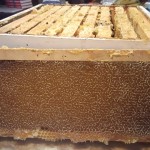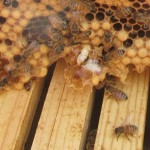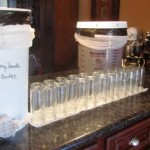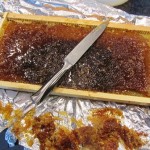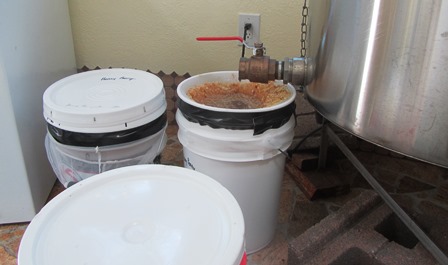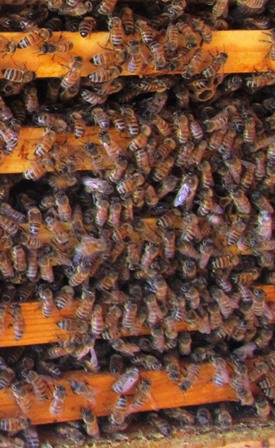Harvesting Honey–Helping Hands Always Welcome
When it comes to opening the hives of honey bees here on our farmette, I’m grateful for the helping hands of my hubby and my neighbor. Carlos, my hubby and helpmate for life, is my go-to guy for all our farm projects. And our neighbor Peter not only has answers to my questions about bees, but also he can open a hive, remove frames of honey, inspect and medicate, and seal the unit lickety-split.
With the smoker at the ready and lit, we opened our hives September 23, 2018. The hives were robust, but the bees appeared stressed. I had added supers to each hive in late July but should have kept a closer eye on the burgeoning bee population. They had become overcrowded and hungry.
For harvesting, we first removed the heavy metal lid of the hive box, replacing it with a fume board. A fume board is a lid lined with fabric that is sprayed with a product that encourages the bees to vacate the supers (some bees immediately leave the box; others go into the brood chambers). The fume board works within seven to ten minutes. We then pulled out the frames of honey, gently brushed off any remaining bees, and took the honey-heavy frames to the kitchen.
For an old hand at beekeeping like my neighbor, the process went quick. Not so for me. This past year, I injured both my shoulders with tears in the rotator cuff tendons. With limitation to some of my range of motion, I’ve felt pretty handicapped. Still, I helped by carrying a single frame of honey at a time from the hive box to the kitchen.
While the hives were open, we removed old medicated strips previously hung in the boxes to thwart mites.
- Small sheets for trapping hive beetles are placed across the frames in the top super before closing the lid
We also replaced the Bee-Gone sheets to trap hive beetles. It’s important to properly handle such items and to keep the apiary clean. We put in medication for mite control–a white gelatinous substance spread on a paper similiar to an index card. Finally, we placed a single patty of bee food on the frames to provide for the bees’ nutritional needs.
The bees immediately coalesced on the patty; no longer stressed, they seemed gentle and calm. Checking the bottom frames, we found a lot of brood (eggs, larvae and pupae of bees). To help this new generation of honey bees along, we inserted an unopened frame of honey that I’d kept wrapped in foil and frozen (freezing kills any insects that could infect the hive or bees). Honey, of course, is the perfect food for them.
We will reopen the hives in two weeks and re-check the status of the bees. A that time, we’ll treat with an antibiotic for winter and possibly add a super if necessary.
I haven’t yet processed the honey we harvested but the frames are on my kitchen counter. They are in a hive box wrapped in aluminum foil. At the ready are also several food-grade buckets that I’ve carefully washed, dried, and covered with lids. The honey spinning machine has been cleaned. Before I begin working with the honey in the frames, I always scrub my kitchen, washing the countertops twice–first with soap and water and then with diluted bleach and hot water.
When everything is clean, I will begin to work on each frame. I first scrape away any bee “glue” from the outside edges of the frame. With a hot knife, I slice all around the interior edges before opening the sealed wax cells (sliding the hot knife just under the wax and lifting). Both sides of the frame are dealt with in this manner. After the wax cells are uncapped, the frame will be placed into the spinning machine. It uses centrifugal force to spin off the honey. The sweet stuff then drains through the strainer material taped around the bucket mouth. The bucket is positioned under the machine spigot.
My reward for this labor of love is having an abundance of sweet, amber honey when desired to bake a honey cake or other culinary creation, to enjoy a relaxing cup of tea, or to fill jars for holiday gift-giving. Beekeeping draws people together and, take it from me, a helping hand is always appreciated.
_______________________________________________________________________________
If you enjoy reading about keeping bees and chickens, growing heirloom vegetables and fruits, or living the farmette (small farm) life, check out my offering of books that tie into themes of living well and close to the Earth.
Grab one or more of my cozy mysteries (no gratuitous sex, profanity, or violence) and discover delicious farm recipes, gardening advice, and tips for caring for bees and chickens.
Or pick up one of my wellness, spirituality, or manifesting books. They make great holiday gifts for yourself and others.
All my books are available in traditional bookstores everywhere and also online at Amazon.com, Barnes & Noble (barnesandnoble.com), Kobo Books, Walmart, and other retailers.
For more information, click on the following URLs:
A HIVE OF HOMICIDES
MURDER OF A QUEEN BEE
A BEELINE TO MURDER

More than 150 rituals for sound mind, strong body, and meaningful connections to the people around you
https://www.amazon.com/dp/B0719HHVRJ/ref=dp-kindle-redirect?_encoding=UTF8&btkr=1
Pulling Honey–A Bee-eautiful Sight to See
Nothing compares to the reward of pulling honey from a hive when you are a beekeeper. Over the last two days, this is what I’ve done with the help of my world-class beekeeper neighbor who knows more about keeping honeybees than anyone I’ve ever met.
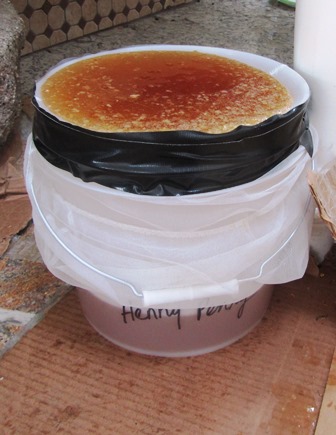
Pictured is a Henny Penny Farmette honey bucket with strainer taped on and bits of wax in the honey on top
His wife helped me scrape off the bee glue from each frame and then open the capped cells (a must) before draining the honey. We then used their machine that can spin twenty frames at a time. It has an electric motor and a control to increase or decrease the speed. Use slow speed to begin and then when the frames grow lighter, you increase the speed.
In all, I spun four hive boxes full (ten frames each), except for one box that had fewer because we left two frames behind in the apiary. They still had babies in them.
We taped fine-mesh filters over the tops of several five-gallon buckets. To spin the honey out of the first eighteen frames took many hours, from noon to about ten o’clock at night. We left the machine spigot open all night to allow the draining to continue into the bucket. The filters caught bits of wax and even the occasional dead bee, ensuring the honey would be perfectly clean and ready to bottle.
I drained honey from the ten frames in each of my hive boxes–two of my hive boxes held the large frames and two held smaller frames. In all, we spun and drained enough honey to fill three five-gallon buckets and about one-fourth of a two and one-half gallon bucket.
Not a bad yield for a fairly young hive and during summer in a drought year when pollen-laden flowers are not be as plentiful. It’s a bee-eautiful sight to see!
A False Swarm . . . Sort Of
When I heard my neighbors banging on a pan with a wooden spoon, I sprang into action. It is what we do when a honeybee hive swarms.
As it turned out, my bees had swooped from the hive with their queen into the front yard, past the plum tree and were circling above the blood orange. My neighbors, who were in their courtyard, saw it and began the banging to confuse the bees so they would alight close to their home.
I ran out and, with direction from my beekeeper neighbor, placed the hive near the orange tree. I’d already placed eight frames with wax and my neighbor brought over two with honey on the comb. All seemed to go as planned. We shook the tree and the bees dropped into the prepared hive.
My neighbor went home, and I went back to my computer and the novel I’m writing. Thirty minutes later, the bees were swarming again. I ran out and banged on the pan. They settled down. All seemed well, except for ants that had been in the orange tree and now were in the hive box.
Around nine o’clock at night, I sprayed the outside of the hive with Windex and wiped it with paper towels. I repeated the procedure around the perimeter of the box, replaced the lid, and carried the hive box back to the apiary believing all would be well. It wasn’t.
This morning, I ran out and suited up in my beekeeper’s outfit and gloves, opened the new hive box, and looked in. To my dismay, all the bees were gone.
My neighbor later told me over coffee that the bees had likely returned to their old hive as small swarms sometimes do. So . . . I suppose I may be repeating this whole scenario at some point in the days ahead. My neighbor reminded me that the weather has been strange, and the weather affects the bees’ behavior.
 Facebook
Facebook Goodreads
Goodreads LinkedIn
LinkedIn Meera Lester
Meera Lester Twitter
Twitter






